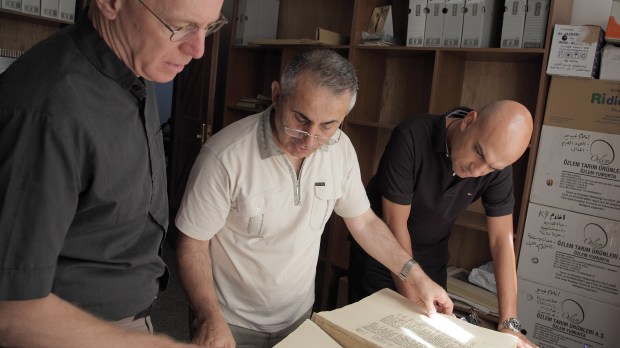A project to preserve ancient European monastic manuscripts in the face of threats during the Cold War has expanded throughout the world and most recently has helped save precious writings in Syria and Iraq.
Fr. Columba Stewart, a Benedictine monk and executive director of the Hill Museum & Manuscript Library (HMML) at St. John’s University in Collegeville, Minnesota, outlined the work of that project in Washington in 2018. Fr. Stewart delivered the National Endowment for the Humanities Jefferson Lecture in the Humanities Oct. 7, 2018.
“A ‘Monument Man’ of our time, Father Columba Stewart has dauntlessly rescued centuries’ worth of irreplaceable cultural heritage under threat from around the world,” said NEH Chairman Jon Parrish Peede. “In doing so, he and his colleagues have helped preserve the records of the religion, art, literature, culture, and knowledge of distant eras of human history so that we may celebrate and learn from those that came before us.”
Fr. Stewart’s predecessor, Fr. Oliver Kapsner, founded HMML in 1965, fearing that the European Benedictine heritage “would be vaporized if there were a World War III,” Fr. Stewart said in the Jefferson lecture.
“Monte Cassino in Italy, the mother abbey of Benedictines, had been totally destroyed in 1944,” he told his audience. “A nuclear war would be far more devastating. There was not anything we monks in Minnesota could do to protect the churches and cloisters, but we could microfilm their manuscripts and keep a back-up copy in the United States.”
The Vatican Library had done something similar in the 1950s, depositing microfilms of many of their manuscripts at St. Louis University in Missouri.
“Our project started in Benedictine monasteries in Austria, employing local technicians, as we always do, to involve them in the preservation of their own heritage,” the priest explained. “Austria was one of the few countries in Europe where monastic libraries had not been seized during the Reformation or the French Revolution and its aftermath. The scope of the work soon widened to libraries of other religious orders, then to universities and national libraries.”
In the early 1970s, the project expanded to Ethiopia, where manuscripts in monasteries and churches were captured on microfilm. And in 2003, HMML got an invitation to do similar work in Lebanon. While that work was going on, it received an invitation from Syria, where work got underway just before the Arab Spring and the Syrian civil war.
Meanwhile, in Iraq, a Dominican priest, Najeeb Michaeel (in photo, center, with Fr. Stewart at left), had already established a center for digitization of Christian manuscripts in the Christian village of Qaraqosh. HMML helped him digitize thousands of Syriac, Arabic, and Armenian manuscripts. In 2014, after the Islamic State group took over Mosul, Michaeel (who is now the Chaldean Archbishop of Mosul) took the precaution of moving the precious manuscripts out of Qaraqosh, even though it was not expected that ISIS would move eastward of Mosul. But they did.
Along with the gruesome treatment ISIS meted out to “infidels” and the destruction it incurred upon places like the Mosul Museum and the ancient city of Palmyra, they also destroyed major manuscript collections in Mosul, “leaving behind only the digital images and a handful of severely damaged volumes,” Fr. Stewart said. “Most collections outside of Mosul, however, had been saved: moved at the last minute, or successfully concealed. This was the case at Mar Behnam Monastery, where some 500 manuscripts were hidden behind a false wall and never discovered during the two-year occupation of the monastery by ISIS. When the monks returned to their now wrecked and defaced monastery, where ISIS had blown up the shrines of the saints to whom the monastery was dedicated, they found the manuscripts intact, safe in their hiding place, a still-beating heart in the battered and bruised body of the cloister.”
Today, HMML has a growing digitized collection of more than 250,000 handwritten books and 50 million handwritten pages. The work is vitally important to helping scholars gain a deeper understanding of ancient cultures, Fr. Stewart said.
“Anything written before the invention of printing has come down to us in the form of a manuscript,” he said during the Jefferson lecture. “A surprising number of those texts have not yet been printed or put online, and we keep finding new texts in manuscripts that have lain hidden for centuries. In many parts of the world, printing came late or was little used, meaning that even less of the literature of these communities is available in modern formats. To know what is most important to such communities, to understand the questions they asked and what gave them purpose and identity, we need to read their manuscripts.”
It is often said that Jews, Christians, and Muslims are “People of the Book,” Fr. Stewart noted. “In fact, we were and are people of many books, as are those who follow ancient philosophies or other great religious traditions,” he said. “In those books are stories, reflections on stories, ideas spun from human observation and experience, attempts to trace how our universe exists and functions in space and time. These books changed the world because their words were heard. They were taken seriously, seriously enough at times to prompt rebuttal or controversy, admiration or adoption. But they were heard.”
That example of listening, he concluded, is a lesson we need to learn today, when “we are at great risk of losing the capacity to listen, and therefore losing our ability to understand.”

